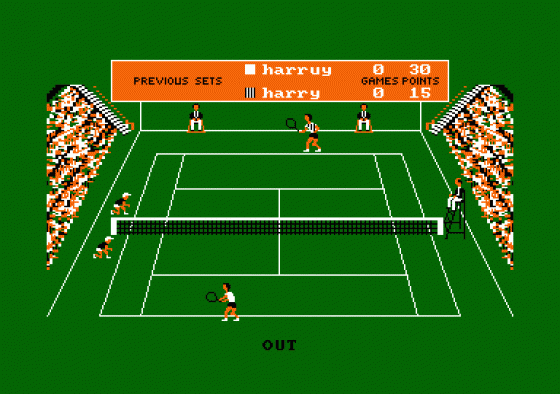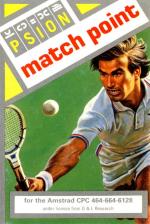
Amstrad Action
 1st March 1986
1st March 1986
Categories: Review: Software
Publisher: Psion
Machine: Amstrad CPC464
Published in Amstrad Action #6
Match Point
Only one other tennis simulation has been tried on the Amstrad and that was very dire, leaving a gap in the market for a decent attempt at the sport. That space has now been filled by this highly demanding, but rewarding, game which really does give you a taste of the difficulty and atmosphere of the real thing.
The whole of the tennis court is shown on the screen at once with a view from above and behind one end of it. This gives you a camera angle view of the proceedings with the umpire, ball boys, crowd and score board all in sight. The court narrows at the top because of the perspective and this also has a major effect on the play, making the top end a lot harder to play at and judge the ball's arrival.
One or two player games can be played. The more intrepid can risk a drubbing by the computer while the lazy can sit and watch two computer players battle it out. The game can also be played on three levels: quarter final, semi-final and final. These are of increasing difficulty but against the computer even the first level is extremely tough.

Games are played over five sets and follow all of the rules of tennis including tie-breaks and end changes. The breaks between games are very short, but when you are serving you can leave the player bouncing the ball for as long as you like if you need a breather (wipe the sweat off your brow, change shirts or rackets, etc).
Control of the player may at first seem limited since you can only move him around and press fire to swing the racket. However the skill involved is in the positioning of the player and the speed of the racket swing. Once this fine art has been learnt, a wide range of shots can be played although I haven't managed to execute a lob or drop shot yet. As well as the timing of shots, a tactical sense is needed, as in the real game. Your shots should be played to keep the other player on the run and playing defensively rather than let him dominate the net and play outright winning strokes that you can't reach.
When you are rushing around the court after the ball, the computer will automatically switch from forehand to backhand but I found this often didn't work well and that manual control over the racket using the fire button was far more reliable. Now you've got all that information and a few practice games under your belt try taking on the computer and see just how good you've got to get.

Even on the easiest quarter final level, the computer is tough but you should soon be able to take the odd game off him and in time perhaps even a set. To do so, there are two main tactics to perfect: the serve/volley game, where you charge into the net or; baseline tactics where you wear down the opponent with long rallies. With either tactic, the important thing to remember is that while moving forward on the serve or shot as you swing, extra speed is put on the ball, thus giving you better chances of beating your opponent.
If the challenge of playing the computer is too much then a human opponent should provide more balanced opposition and close exciting games are much more likely to result. On the whole it's a good simulation; it's a pity the computer opponent doesn't have a slightly easier level. It does, though, provide a lasting challenge. I don't think anyone will ever beat the computer on the final level - it's just too fast.
Second Opinion
This is a very attractive game, marred only by the virtual impossibility of ever thrashing your computer opponent. Well, you could try the McEnroe tactics, but I'm afraid the umpire always turns a deaf ear. Of course, that does mean you won't be fined either. Against another humanoid, things are a lot more sensible.
Good News
P. Very tough computer opponent.
P. Excellent two player action.
P. Very realistic and skillful simulation.
P. Nice touch when the ball boys pick up balls hit into the net.
Bad News
N. Solitary players will spend a very long time trying to master the game.
N. If you aren't a tennis fan, forget it.







